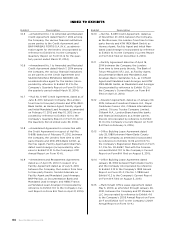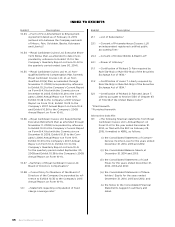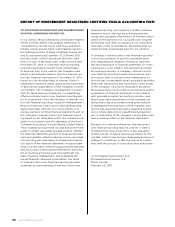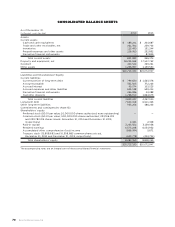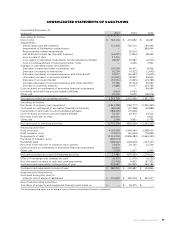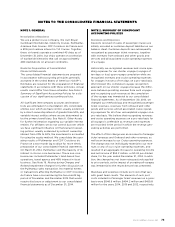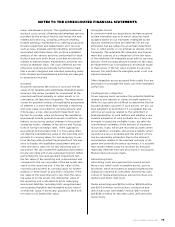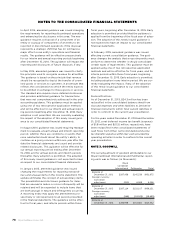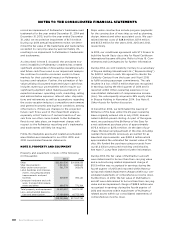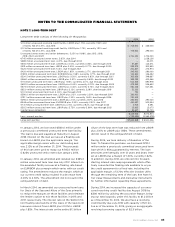Royal Caribbean Cruise Lines 2014 Annual Report Download - page 75
Download and view the complete annual report
Please find page 75 of the 2014 Royal Caribbean Cruise Lines annual report below. You can navigate through the pages in the report by either clicking on the pages listed below, or by using the keyword search tool below to find specific information within the annual report.
74 Royal Caribbean Cruises Ltd.
NOTES TO THE CONSOLIDATED FINANCIAL STATEMENTS
Cash and Cash Equivalents
Cash and cash equivalents include cash and market-
able securities with original maturities of less than
90 days.
Inventories
Inventories consist of provisions, supplies and fuel
carried at the lower of cost (weighted-average)
or market.
Property and Equipment
Property and equipment are stated at cost less accu-
mulated depreciation and amortization. We capitalize
interest as part of the cost of acquiring certain assets.
Improvement costs that we believe add value to our
ships are capitalized as additions to the ship and
depreciated over the shorter of the improvements’
estimated useful lives or that of the associated ship.
The estimated cost and accumulated depreciation of
replaced or refurbished ship components are written
off and any resulting losses are recognized in Cruise
operating expenses. Liquidated damages received
from shipyards as a result of the late delivery of a new
ship are recorded as reductions to the cost basis of
the ship.
Depreciation of property and equipment is computed
using the straight-line method over the estimated use-
ful life of the asset. The useful lives of our ships are
generally 30 years, net of a 15% projected residual
value. The 30-year useful life of our newly constructed
ships and 15% associated residual value are both based
on the weighted-average of all major components
of a ship. Our useful life and residual value estimates
take into consideration the impact of anticipated
technological changes, long-term cruise and vacation
market conditions and historical useful lives of similarly-
built ships. In addition, we take into consideration our
estimates of the weighted-average useful lives of the
ships’ major component systems, such as hull, super-
structure, main electric, engines and cabins. Deprecia-
tion for assets under capital leases is computed using
the shorter of the lease term or related asset life.
Depreciation of property and equipment is computed
utilizing the following useful lives:
Years
Ships generally
Ship improvements –
Buildings and improvements –
Computer hardware and
software –
Transportation equipment
and other –
Leasehold improvements
Shorterofremaininglease
termorusefullife–
Effective January 1, 2013, we revised the estimated
useful lives of five ships from 30 years with a 15%
associated residual value, to 35 years with a 10%
associated residual value. The change in the esti-
mated useful lives and associated residual value was
accounted for prospectively as a change in account-
ing estimate. The 35-year useful life with a 10% asso-
ciated residual value is based on revised estimates
of the weighted-average useful life of all major ship
components for these ships. The change in estimate is
consistent with our recent investments in and future
plans to continue to invest in the upgrade of these
ships and the use of certain ship components longer
than originally estimated. The change allows us to
better match depreciation expense with the periods
these assets are expected to be in use. For the full
year 2013, this change increased operating income
and net income by approximately $11.0 million and
increased earnings per share by $0.05 per share on
a basic and diluted basis.
We review long-lived assets for impairment whenever
events or changes in circumstances indicate, based
on estimated undiscounted future cash flows, that
the carrying amount of these assets may not be fully
recoverable. For purposes of recognition and meas-
urement of an impairment loss, long-lived assets are
grouped with other assets and liabilities at the lowest
level for which identifiable cash flows are largely inde-
pendent of the cash flows of other assets and liabilities.
The lowest level for which we maintain identifiable
cash flows that are independent of the cash flows of
other assets and liabilities is at the ship level for our
ships and at the aggregated asset group level for our
aircraft. If estimated future cash flows are less than
the carrying value of an asset, an impairment charge
is recognized to the extent its carrying value exceeds
fair value.
We use the deferral method to account for drydock-
ing costs. Under the deferral method, drydocking
costs incurred are deferred and charged to expense
on a straight-line basis over the period to the next
scheduled drydock, which we estimate to be a period
of thirty to sixty months based on the vessel’s age
as required by Class. Deferred drydock costs consist
of the costs to drydock the vessel and other costs
incurred in connection with the drydock which are
necessary to maintain the vessel’s Class certification.
Class certification is necessary in order for our cruise
ships to be flagged in a specific country, obtain liability
insurance and legally operate as passenger cruise ships.
The activities associated with those drydocking costs
cannot be performed while the vessel is in service
and, as such, are done during a drydock as a planned


